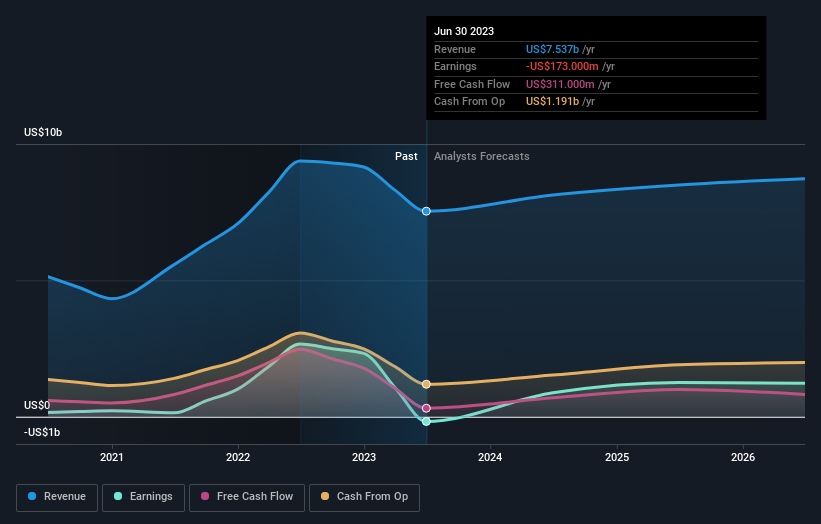- Australia
- /
- Metals and Mining
- /
- ASX:S32
South32 Limited (ASX:S32) surges 4.8%; retail investors who own 58% shares profited along with institutions

Key Insights
- The considerable ownership by retail investors in South32 indicates that they collectively have a greater say in management and business strategy
- A total of 25 investors have a majority stake in the company with 37% ownership
- 36% of South32 is held by Institutions
If you want to know who really controls South32 Limited (ASX:S32), then you'll have to look at the makeup of its share registry. We can see that retail investors own the lion's share in the company with 58% ownership. Put another way, the group faces the maximum upside potential (or downside risk).
Retail investors gained the most after market cap touched AU$16b last week, while institutions who own 36% also benefitted.
In the chart below, we zoom in on the different ownership groups of South32.
See our latest analysis for South32

What Does The Institutional Ownership Tell Us About South32?
Many institutions measure their performance against an index that approximates the local market. So they usually pay more attention to companies that are included in major indices.
We can see that South32 does have institutional investors; and they hold a good portion of the company's stock. This can indicate that the company has a certain degree of credibility in the investment community. However, it is best to be wary of relying on the supposed validation that comes with institutional investors. They too, get it wrong sometimes. It is not uncommon to see a big share price drop if two large institutional investors try to sell out of a stock at the same time. So it is worth checking the past earnings trajectory of South32, (below). Of course, keep in mind that there are other factors to consider, too.

South32 is not owned by hedge funds. BlackRock, Inc. is currently the company's largest shareholder with 7.0% of shares outstanding. South Africa is the second largest shareholder owning 5.7% of common stock, and The Vanguard Group, Inc. holds about 5.2% of the company stock.
On studying our ownership data, we found that 25 of the top shareholders collectively own less than 50% of the share register, implying that no single individual has a majority interest.
While studying institutional ownership for a company can add value to your research, it is also a good practice to research analyst recommendations to get a deeper understand of a stock's expected performance. Quite a few analysts cover the stock, so you could look into forecast growth quite easily.
Insider Ownership Of South32
While the precise definition of an insider can be subjective, almost everyone considers board members to be insiders. Company management run the business, but the CEO will answer to the board, even if he or she is a member of it.
Most consider insider ownership a positive because it can indicate the board is well aligned with other shareholders. However, on some occasions too much power is concentrated within this group.
Our most recent data indicates that insiders own less than 1% of South32 Limited. Being so large, we would not expect insiders to own a large proportion of the stock. Collectively, they own AU$16m of stock. It is always good to see at least some insider ownership, but it might be worth checking if those insiders have been selling.
General Public Ownership
The general public -- including retail investors -- own 58% of South32. This size of ownership gives investors from the general public some collective power. They can and probably do influence decisions on executive compensation, dividend policies and proposed business acquisitions.
Next Steps:
It's always worth thinking about the different groups who own shares in a company. But to understand South32 better, we need to consider many other factors. Consider for instance, the ever-present spectre of investment risk. We've identified 1 warning sign with South32 , and understanding them should be part of your investment process.
If you would prefer discover what analysts are predicting in terms of future growth, do not miss this free report on analyst forecasts.
NB: Figures in this article are calculated using data from the last twelve months, which refer to the 12-month period ending on the last date of the month the financial statement is dated. This may not be consistent with full year annual report figures.
New: Manage All Your Stock Portfolios in One Place
We've created the ultimate portfolio companion for stock investors, and it's free.
• Connect an unlimited number of Portfolios and see your total in one currency
• Be alerted to new Warning Signs or Risks via email or mobile
• Track the Fair Value of your stocks
Have feedback on this article? Concerned about the content? Get in touch with us directly. Alternatively, email editorial-team (at) simplywallst.com.
This article by Simply Wall St is general in nature. We provide commentary based on historical data and analyst forecasts only using an unbiased methodology and our articles are not intended to be financial advice. It does not constitute a recommendation to buy or sell any stock, and does not take account of your objectives, or your financial situation. We aim to bring you long-term focused analysis driven by fundamental data. Note that our analysis may not factor in the latest price-sensitive company announcements or qualitative material. Simply Wall St has no position in any stocks mentioned.
About ASX:S32
Undervalued with excellent balance sheet.
Similar Companies
Market Insights
Community Narratives




